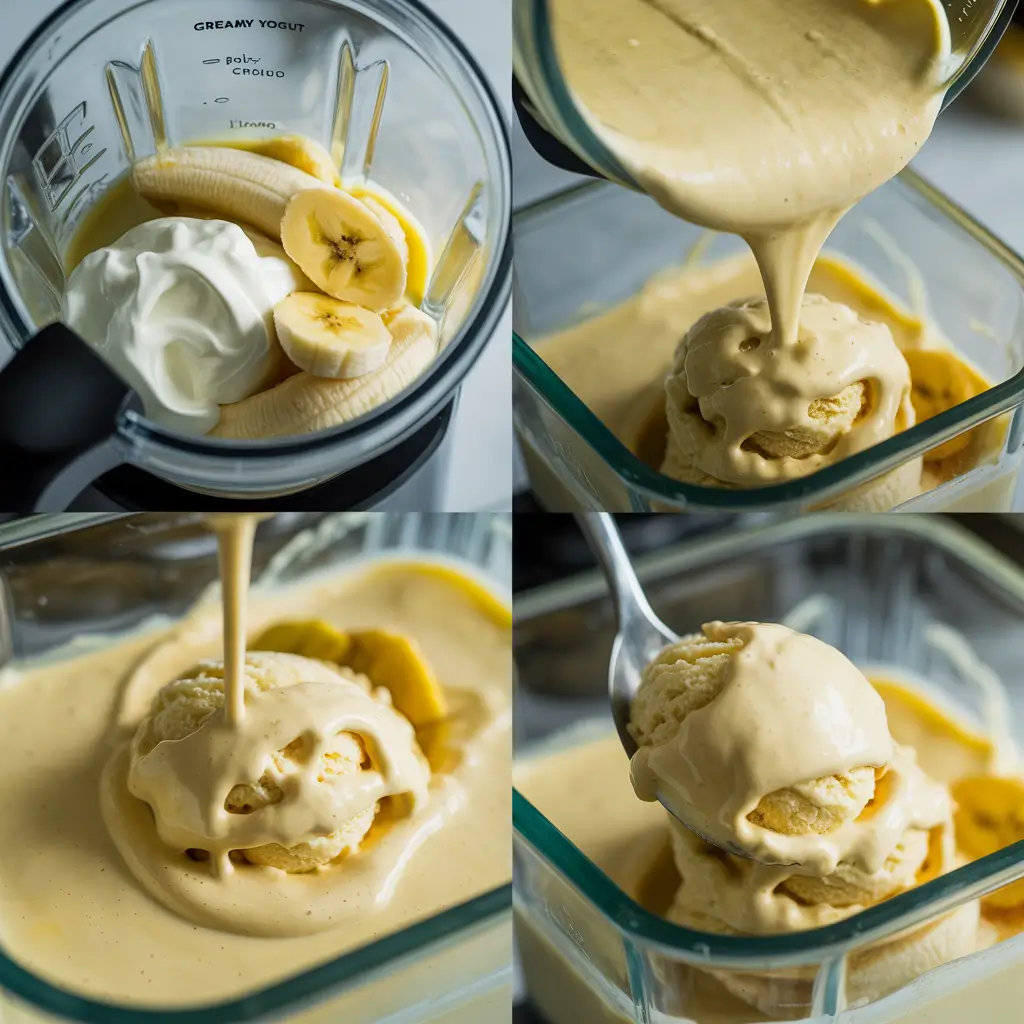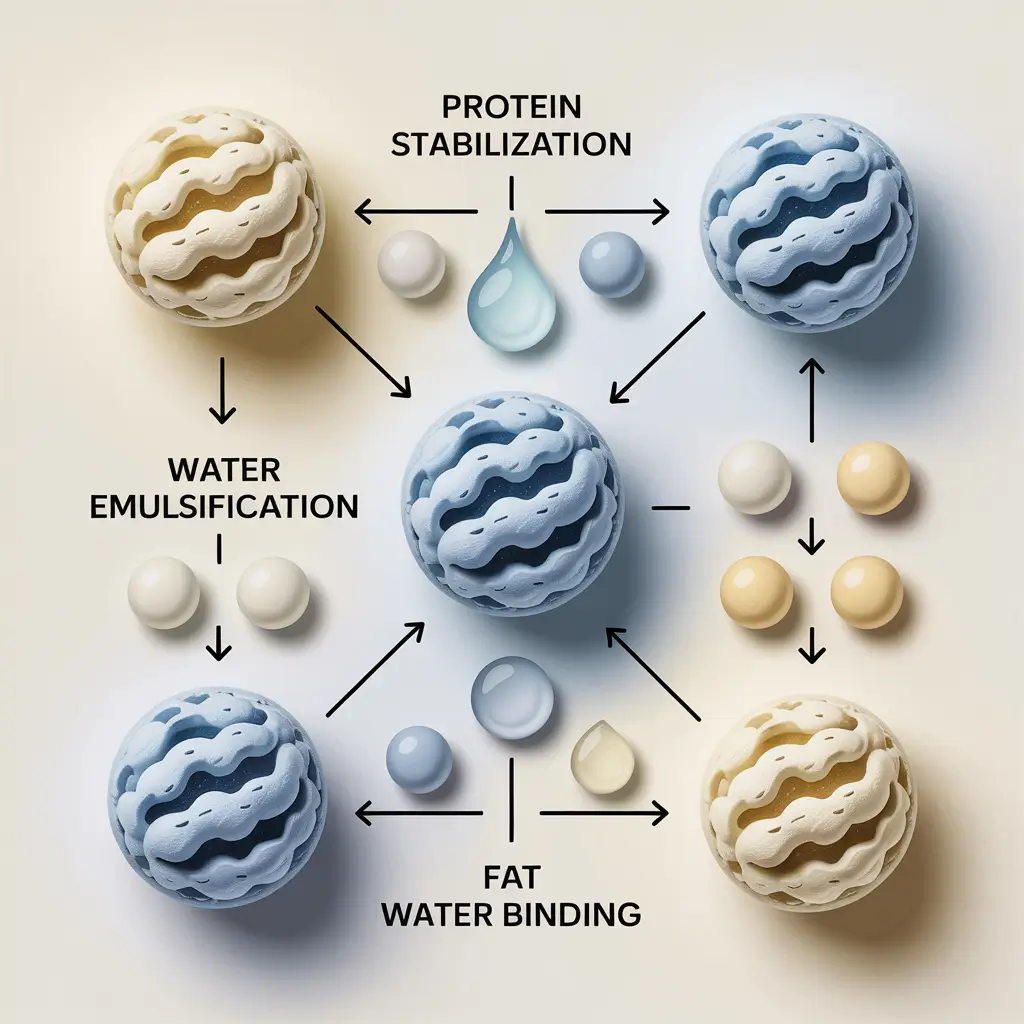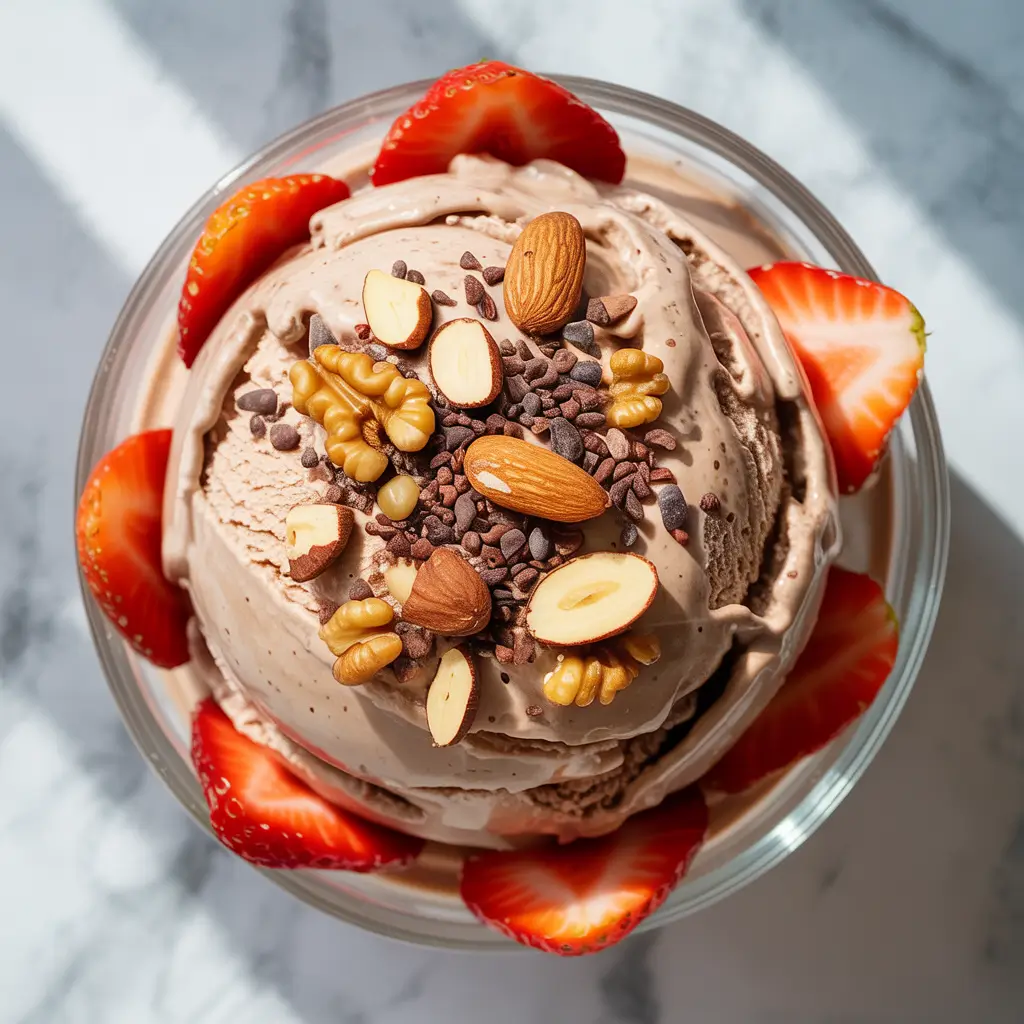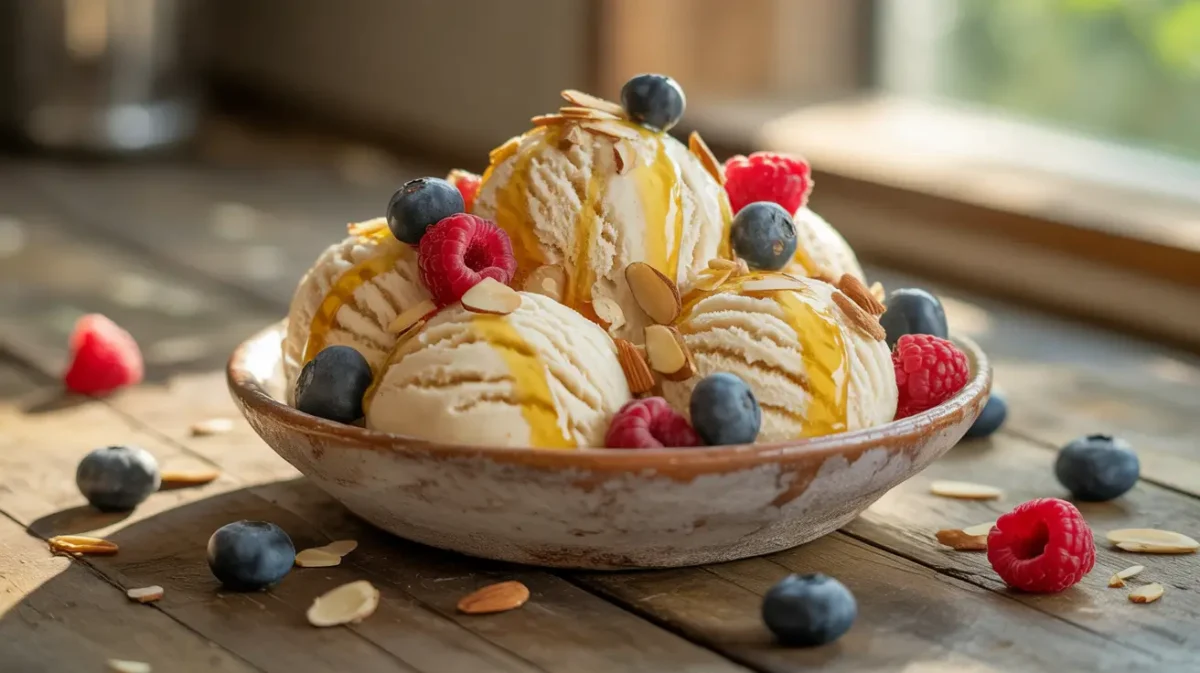Introduction
Protein ice cream Whole Foods is quickly becoming the dessert world’s healthiest indulgence. Popular brands like Halo Top and Arctic Zero started the craze, but not everyone wants a frozen treat filled with gums, isolates, and sugar alcohols. The real shift is toward cleaner, simpler, and whole-food versions that feel indulgent but nourish the body, too.
Unlike many protein-packed pints that rely on artificial stabilizers and chalky powders, Whole Foods–style ice cream focuses on natural protein sources such as Greek yogurt, nut butter, and milk. The result? A creamy, high-protein dessert made with ingredients your body recognizes.
In this guide, you’ll learn what makes protein ice cream unique, why it’s trending, and how to create your own smooth, nutrient-rich version at home. Chef Ruby tested several variations and discovered the perfect balance of flavor and nutrition — no processed additives required.
Looking for inspiration? Try our Protein Ice Cream (Banana-Free, 28 g Protein) recipe to see how delicious healthy desserts can be.
PrintProtein Ice Cream Whole Foods: Creamy, Clean & High in Protein
This protein ice cream Whole Foods–style is creamy, naturally sweet, and made with real, nourishing ingredients like Greek yogurt, banana, and nut butter — no powders or additives needed.
- Prep Time: 5 minutes
- Cook Time: 0 minutes
- Total Time: 3 hours (freeze time)
- Yield: 1 pint (2–3 servings) 1x
- Category: High Protein Dessert
- Method: Blended & Frozen
- Cuisine: Whole Foods Style
Ingredients
- 1 cup Greek yogurt (full-fat)
- 1 ripe banana
- ½ cup milk or almond milk
- 1 tablespoon nut butter (almond or peanut)
- 1 tablespoon honey or maple syrup
- ½ teaspoon vanilla extract
- Pinch of sea salt
Instructions
- Combine all ingredients in a blender.
- Blend until completely smooth and creamy.
- Pour mixture into a chilled container.
- Freeze for 2–3 hours, stirring halfway through for a soft-serve texture.
- For a scoopable finish, churn the mixture in an ice cream maker before freezing.
- Let sit at room temperature for 5–10 minutes before scooping and serving.
Notes
To prevent ice crystals, use banana and nut butter for natural texture balance. A tablespoon of vodka can also reduce crystallization if storing long term.
Nutrition
- Serving Size: ½ cup
- Calories: 180
- Sugar: 10g
- Sodium: 60mg
- Fat: 6g
- Saturated Fat: 2g
- Unsaturated Fat: 4g
- Trans Fat: 0g
- Carbohydrates: 12g
- Fiber: 2g
- Protein: 18g
- Cholesterol: 10mg
Keywords: protein ice cream, whole foods dessert, Greek yogurt ice cream, healthy ice cream, clean dessert
What Is Protein Ice Cream (and Why It’s Trending at Whole Foods?)
What It Is
Protein ice cream is a frozen dessert with higher protein and lower sugar than traditional ice cream. It’s made for people who want a satisfying treat without sacrificing their fitness goals. Most store-bought options use protein isolates, sweeteners, and emulsifiers to maintain texture — but the Whole Foods version takes a simpler route, using real food proteins and natural fats for creaminess.
Why It’s Trending
There’s a reason it’s showing up in every freezer aisle:
- Fitness meets flavor. People want treats that support muscle recovery and satiety.
- Clean eating appeal. Consumers trust labels with short, real-ingredient lists.
- Whole Foods standard. The brand’s commitment to transparency makes it the perfect home for guilt-free, nutritious desserts.
As reviewers from PureWow and Zestolla note, the best protein ice creams balance nutrition with taste — something industrial versions often miss. This article goes a step further by showing how to make your own whole-food protein ice cream from scratch.
For more high-protein ideas, check out our High Protein Low Carb Lunch guide for balanced meal prep inspiration.
Whole-Food vs. Industrial Versions
Commercial protein ice creams depend on isolates and sugar alcohols. Whole-food versions rely on ingredients like Greek yogurt, bananas, and nut butter, delivering authentic creaminess and better digestion. They taste richer, feel smoother, and align with the Whole Foods philosophy — fewer additives, more nourishment.
Don’t miss our Protein Pancake Mix: Benefits & Recipes if you love boosting your breakfast with clean protein power.
The Whole Foods Approach: Simple, Natural, Real
What “Whole Food” Really Means in Protein Desserts
When it comes to protein ice cream Whole Foods, the key difference isn’t the protein count — it’s the ingredients. A whole-food dessert uses real, recognizable items you’d find in your kitchen, not a lab. Instead of processed powders, you get nutrition from Greek yogurt, nut butters, full-fat milk, fruits, and natural sweeteners like honey or dates. These ingredients offer not just protein but also healthy fats, vitamins, and fiber that make your ice cream both creamy and satisfying.
This approach reflects the Whole Foods philosophy: less processing, more nourishment. With minimal ingredients and no artificial stabilizers, your body digests the protein more efficiently and retains more nutrients. The result is a dessert that tastes richer, feels smoother, and supports real wellness — not just macros.
Why “Whole Food” Protein Ice Cream Is Better
Whole-food protein sources like Greek yogurt or cottage cheese provide a balanced amino acid profile, probiotics for gut health, and natural creaminess that powders can’t replicate. Unlike commercial versions, you don’t need emulsifiers to achieve a silky texture — natural fats and sugars handle it beautifully.
Discover great ideas like our High Protein Low Carb Lunch for more simple, whole-food meals that fuel your day the same clean way your dessert does.
How to Make Creamy Whole Food Protein Ice Cream at Home

Step-by-Step Base Recipe (Chef Ruby’s Version)
Creating protein ice cream Whole Foods style is easier than you think. Chef Ruby’s version skips processed powders and focuses on nutrient-dense, whole ingredients. Here’s her favorite base recipe — smooth, creamy, and naturally sweet.
Ingredients (1 pint)
- 1 cup Greek yogurt (full-fat for creaminess)
- 1 ripe banana (for texture and natural sweetness)
- ½ cup milk or almond milk
- 1 tablespoon nut butter (almond or peanut)
- 1 tablespoon honey or maple syrup
- ½ teaspoon vanilla extract
- Pinch of sea salt
Directions
- Combine all ingredients in a blender.
- Blend until silky smooth.
- Pour into a chilled container and freeze for 2–3 hours, stirring halfway.
- For a softer texture, churn in an ice cream maker before freezing.
This recipe creates a balanced dessert — creamy from healthy fats, sweetened naturally, and packed with real-food protein.
The Texture Secret: How to Avoid Ice Crystals
The secret to scoopable whole food protein ice cream lies in the water-fat-sugar balance. Too much water causes ice crystals; too little fat or sugar leads to icy texture. Chef Ruby’s trick? Add banana, nut butter, or even a tablespoon of vodka — all help prevent crystallization.
Don’t miss our Protein Pancake Mix: Benefits & Recipes for another way to use natural protein sources creatively in your diet.
Protein Choices: Which Works Best for Ice Cream Texture?

When crafting protein ice cream Whole Foods style, the protein source you choose determines everything — from creaminess to flavor and even digestibility. Each option behaves differently when frozen, so selecting the right one makes or breaks your dessert.
The Right Protein for the Perfect Scoop
Whole-food proteins like Greek yogurt, cottage cheese, or nut butter naturally thicken and add richness, while powders like whey or pea protein often need extra fat to stay smooth. Here’s a quick comparison of common protein sources and how they perform in ice cream.
| Type | Texture | Flavor | Digestibility | Notes |
|---|---|---|---|---|
| Whey Isolate | Smooth | Neutral | Easy | Great all-rounder; needs fat for creaminess. |
| Casein | Creamy | Mild dairy | Slow | Adds structure and richness. |
| Pea Protein | Slightly gritty | Earthy | Vegan-friendly | Blend with healthy fats for best texture. |
| Greek Yogurt | Thick | Tangy | Excellent | Natural probiotic base, adds volume and taste. |
| Cottage Cheese | Creamy | Mild | Excellent | Balances protein and fat perfectly. |
The best option? A Greek yogurt or cottage cheese base. Both contain natural milk proteins and fats that create smooth, scoopable consistency without artificial stabilizers.
Looking for inspiration? Explore the High Protein Low Carb Lunch guide for complementary meals that pair beautifully with your healthy dessert creations.
Chef Ruby’s Taste Test: 3 Versions, 1 Winner
To find the best protein ice cream Whole Foods version, Chef Ruby tested three different recipes — one made with whey protein, one with only whole-food ingredients, and a vegan alternative using pea protein and coconut milk. Each version was evaluated for texture, flavor, and nutrition balance.
Version A: With Whey Powder
This batch delivered a light, smooth texture but lacked the creamy richness of a traditional scoop. The whey added noticeable protein density, yet it created a slightly icy mouthfeel after freezing. While decent for macros, it felt more like “fitness food” than a dessert.
Version B: All Whole-Food Ingredients
This version used Greek yogurt, banana, and almond butter as the protein and fat base. The texture was velvety and scoopable with no icy edges. Flavor testers loved its natural sweetness and balanced richness. It took longer to freeze but produced the most indulgent mouthfeel — all without any protein powder.
Version C: Vegan (Pea + Coconut Milk)
Smooth and plant-based, this version offered a dense, creamy texture thanks to coconut milk. The flavor was mildly earthy, less sweet, but refreshing for those avoiding dairy.
Chef Ruby’s verdict: The whole-food version wins for both taste and texture. It’s nutrient-rich, easier to digest, and truly embodies the Whole Foods philosophy — real ingredients, real satisfaction.
Don’t miss our Protein Ice Cream (Banana-Free, 28 g Protein) for another delicious variation tested and approved by Chef Ruby.
The Science Behind Protein Ice Cream

How Protein Affects Texture and Satiety
The secret behind the success of protein ice cream Whole Foods recipes lies in how protein interacts with water and fat. Protein molecules bind water, creating a dense and creamy structure that mimics traditional ice cream. This is why blends with Greek yogurt or cottage cheese stay smooth longer — they naturally balance moisture and fat, reducing ice crystal formation.
Beyond texture, protein also plays a big role in satiety. Studies published by the National Institutes of Health (NIH) show that high-protein meals increase feelings of fullness and reduce overall calorie intake throughout the day. That’s part of what makes a scoop of protein ice cream such a smart dessert — it satisfies your sweet tooth and helps curb hunger.
Why Whole-Food Ingredients Make a Difference
While store-bought protein ice creams rely on stabilizers and artificial sweeteners, whole food ingredients like milk, nuts, and yogurt deliver a naturally balanced composition of fats, sugars, and proteins. This structure enhances flavor, improves digestibility, and avoids the “chalky” aftertaste found in many processed alternatives.
Nutrition experts at Zestolla emphasize that real-food sources provide better micronutrient absorption and overall satisfaction. That’s why whole-food recipes not only taste better — they perform better nutritionally too.
For visual inspiration, follow Chef Ruby on Pinterest for more creamy, protein-packed dessert ideas straight from her test kitchen.
Common Myths and Facts About Protein Ice Cream
Even with the rise of protein ice cream Whole Foods products, there’s still a lot of confusion about how healthy or effective they really are. Let’s separate the myths from the facts so you can enjoy your dessert confidently and consciously.
| Myth | Reality |
|---|---|
| “Protein ice cream burns fat.” | ❌ Not directly — it supports satiety and helps manage calorie intake but doesn’t cause fat loss on its own. |
| “Powders make it creamier.” | ❌ Actually, whole fats and sugars from foods like milk or nut butter create a smoother texture naturally. |
| “You can skip churning.” | ❌ Churning (or stirring) prevents ice crystal buildup and ensures a creamy mouthfeel. |
| “It’s expensive to make.” | ✅ When using local, whole ingredients like yogurt, fruit, and milk, homemade versions cost less than store-bought pints. |
| “Vegan versions aren’t creamy.” | ✅ They can be — with coconut milk, avocado, or chia for fat and fiber balance. |
These facts show why making your own whole food protein ice cream beats packaged alternatives every time. You control the ingredients, adjust the sweetness, and maintain the quality Whole Foods stands for — simplicity, nutrition, and natural taste.
Looking for more healthy treats? Visit our Protein Pancake Mix: Benefits & Recipes post for clean, satisfying breakfast options that align with your high-protein lifestyle.
And for wellness tips and community recipes, connect with us on Facebook — where we share daily inspiration for wholesome living.
FAQs About Protein Ice Cream Whole Foods
1. Is protein ice cream actually healthy?
Yes — when made with whole food ingredients like yogurt, nut butter, and fruit, protein ice cream can be a healthy dessert option. It’s rich in protein and lower in refined sugars compared to traditional ice cream.
Source: National Institutes of Health – Protein and Satiety Study
2. What ice cream has a lot of protein in it?
Brands like Halo Top and Enlightened are popular, but the cleanest options are homemade using whole-food protein bases such as Greek yogurt or cottage cheese.
Source: Healthline – Best High-Protein Ice Creams of 2024
3. Does Trader Joe’s have protein ice cream?
Yes. Trader Joe’s offers high-protein frozen desserts made with milk protein concentrate and stevia. However, most are processed, unlike Whole Foods-style recipes that use natural ingredients.
Source: Trader Joe’s Product Finder
4. What exactly is protein ice cream?
Protein ice cream is a frozen dessert fortified with protein from dairy or plant sources. The Whole Foods version replaces isolates with nutrient-rich whole foods, improving digestibility and flavor.
Source: Journal of Food Science – Protein Impact on Ice Cream Microstructure
5. Can I make protein ice cream without protein powder?
Absolutely. Using Greek yogurt, cottage cheese, nut butter, or tofu gives you plenty of protein while maintaining a creamy texture.
Source: Whole Foods Market – Whole Food Dessert Philosophy
Nutrition Breakdown (Per Serving Example)
Here’s the approximate nutrition for each base recipe of protein ice cream Whole Foods style — made with real ingredients, not powders. These values vary based on your protein source and sweetener choice.
| Recipe | Calories | Protein | Fat | Carbs | Fiber |
|---|---|---|---|---|---|
| Greek Yogurt Base | 180 | 18g | 6g | 12g | 2g |
| Vegan Coconut Base | 210 | 14g | 8g | 18g | 3g |
| Peanut Butter Version | 250 | 20g | 10g | 15g | 2g |
All values are approximate and may vary by ingredient choice. Adjust sweetness, fat, or protein level to match your goals.
Chef Ruby’s Final Tips

Chef Ruby’s ultimate rule for whole food protein ice cream is simple: keep it balanced.
- Use full-fat dairy or plant milk for smoother texture and lasting creaminess.
- Chill the mix before freezing — it minimizes ice crystal formation.
- Add fiber with banana, chia seeds, or inulin to stabilize the texture naturally.
- Experiment with flavor — cocoa, espresso, berries, or nut butter all work beautifully.
- Practice portion control. Even clean ice cream is still dessert — enjoy mindfully!
For more clean, high-protein ideas, check out our Protein Ice Cream (Banana-Free, 28 g Protein).
This wraps up Chef Ruby’s Whole Foods-style guide — a delicious blend of real ingredients, smart nutrition, and creamy satisfaction.



1 thought on “Protein Ice Cream Whole Foods: Creamy, Clean & High in Protein”
Comments are closed.